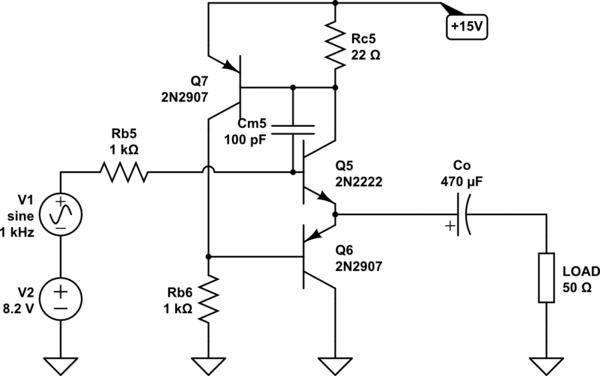goals
The specifications of \$A_v=200\$ (\$\approx 46 \:\text{dB}\$) into \$R_{_\text{L}}=100\:\Omega\$ with \$v_{_{\text{IN}_{PP}}}=10\:\text{mV}\$.
Calculates out to \$v_{_{\text{OUT}_{PP}}}=2\:\text{V}\$. So \$v_{_{\text{OUT}_{PK}}}=1\:\text{V}\$ and \$i_{_{\text{OUT}_{PK}}}=10\:\text{mA}\$.
This also means delivering only \$5\:\text{mW}\$. I'll avoid class-AB. Too much to discuss. And stick with class-A. Fewer quantitative details to worry over.
class-A template starting point
Here's the starting template:

simulate this circuit – Schematic created using CircuitLab
(I'll be using E24 resistor values [5% tolerance]: 1.0, 1.1, 1.2, 1.3, 1.5, 1.6, 1.8, 2.0, 2.2, 2.4, 2.7, 3.0, 3.3, 3.6, 3.9, 4.3, 4.7, 5.1, 5.6, 6.2, 6.8, 7.5, 8.2, 9.1.)
The speaker is bootstrapped by \$C_1\$. This has the advantage of arranging things so that \$R_1\$ can act as a current source. (If you follow the voltages around the loop there, you will see why.)
\$R_5\$ provides global NFB, in conjunction with \$R_3\$. (\$C_3\$ needs to be an effective short at some desired high-enough frequency.) This is how we will set the closed loop voltage gain, \$A_v\$.
\$Q_1\$ and \$Q_2\$ are the 2-quadrant class-A output driver pair and I've centered the midpoint of their output to halfway between the rails. I chose \$I_{_\text{Q}}=12\:\text{mA}\$ and they will each dissipate an average of \$90\:\text{mW}\$. Even without plated through-holes to help, temperature rise should be under \$20^\circ\$C over ambient for small-signal TO-92 packaging. So these are any of 2N2222A, PN2222A, P2N2222A, or 2N3904 (or many others of similar availability for small signal use.)
note on \$V_{_\text{BE}}\$ values
The increase in \$V_{_\text{BE}}\$ due to \$I_{_\text{Q}}=12\:\text{mA}\$ will be compensated by the \$20^\circ\$C rise over ambient so I'm going to just call it as \$V_{_\text{BE}}=700\:\text{mV}\$ for \$Q_1\$ and \$Q_2\$ and set the base voltages as shown above. \$Q_3\$ will probably be closer to \$V_{_\text{BE}}=650\:\text{mV}\$, so I plugged that base voltage into the schematic above, as well.
cross-over at \$150\:\text{kHz}\$
The part of the design that is going to drive me away from the rule-of-10's in biasing the BJTs is the elephant in the room: the cross-over at \$150\:\text{kHz}\$. I want to use a \$47\:\text{pF}\$ Miller cap for the \$Q_3\$ VAS, to manage its parasitic capacitance. But this also means I need to run things hot so that \$R_4\$ can be made small enough.
Given this is already a highly inefficient class-A, running it hot it won't even be noticed. So here's the updated version:

simulate this circuit
That is, without a doubt, insanely hot. But it is the \$500\:\mu\text{A}\$ current that I'm targeting because of \$C_2\$ and because of the \$150\:\text{kHz}\$ cross-over. Better safe than sorry. And with the class-A, it's not going to be noticed that I'm over-doing this to get the needed bandwidth.
some added details
\$26\:\text{mV}\$ at the \$Q_3\$'s base gives me a 10-fold collector current change. I don't think I'll need more. So I might consider \$Q_4\$'s emitter at \$2.5\:\text{V}\$, tentatively, and its base at \$1.8\:\text{V}\$. So it's time to go work out \$Q_4\$'s biasing.
Looks like I can use \$R_6=R_7=36\:\text{k}\Omega\$. \$R_8\$ doesn't work out quite so well, but I'll select \$R_8=240\:\text{k}\Omega\$. That sets \$Q_4\$'s base to \$1.73\:\text{V}\$. Let's update the schematic:

simulate this circuit
I've filled in a bunch more values. I won't explain all of them, as they fall out from the information already determined for the schematic. All I was doing is doing a short calc, selecting a nearby E24 value, and stuffing them in. I did update \$C_3\$. It will need to be hefty.
\$Q_4\$'s \$r_e^{\:'}\approx 50\:\Omega\$, so I know \$R_3\lt 50\:\Omega\$ (\$R_5\$ divided by the gain of 200) may need to be just a little lower. But not much. In any case, that's part of the process once this is built to achieve the designed voltage gain.
validation through simulation
I'm going to plug this into LTspice and tweak \$R_3\$, once there, to get the voltage gain about right. My first guess will be \$R_3=47\:\Omega\$. At this point, I'm scared I missed some important detail. But hopefully, I will get lucky and have covered the important details without error! We shall see:

As you can see in the upper-left corner, it's getting about \$45.9\:\text{dB}\$ into a \$100\:\Omega\$ load. That's \$A_v\gt 197\$. I call that good. I could adjust \$R_3=43\:\Omega\$ to push \$A_v\$ well over the top. But I won't bother. Looks like I saved myself from a redo!
Also, note that the \$-6\:\text{dB}\$ corners are better than spec'd. This means I would either boost \$C_2\$, but may need to find an odd value as I think going to \$100\:\text{pF}\$ might be over-kill. Or else cool it down a bit so that \$R_4=4.7\:\text{k}\Omega\$, \$R_5=18\:\text{k}\Omega\$, and \$R_3=82\:\Omega\$. And that gets the high end. \$C_5\$ could be cut down to about \$150\:\text{nF}\$ to roll off on the low-end at about \$50\:\text{Hz}\$.
These last details are all tweaks I'd do, once the circuit was built, and before presenting it to a teacher for evaluation. They may be impressed with the accuracy and attention to specification details.
schematics note
A schematic sheet should be viewed as a curtain of currents flowing from top to bottom, with signals using that flow to allow themselves to travel across the curtain from left to right. If the above schematic process doesn't manage to clarify that basic idea, nothing else will.









